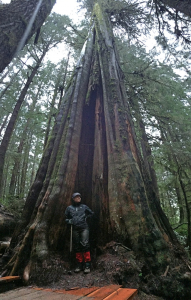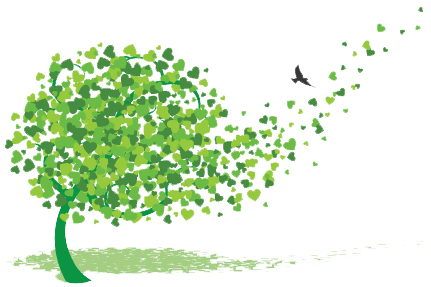B.C.’s Coastal Giants

Andrea Inness
Guest Blogger
The ancient forests and big trees of southwest Vancouver Island.
This blog was written by guest blogger, Andrea Inness.
Near the sleepy town of Port Renfrew on Vancouver Island’s southwest coast, tucked away down bumpy logging roads, are some of the most spectacular trees you’ll ever see. Over centuries, the abundant rainfall, mild temperatures and rich soil characteristic of the island’s temperate rainforests have combined to create massive old growth trees that form part of an ancient ecological system.
Vancouver Island boasts some of the largest Sitka spruce, Douglas fir and western red cedar trees in the world, with some measuring up to 20 metres in circumference and 95 metres (312 feet) high. These big trees support entire ecosystems of plants, fungi, vertebrates and insects, which thrive upon the bark and within piles of needles that accumulate in the canopy.
Ancient temperate rainforests once covered most of coastal Vancouver Island, supporting rich biodiversity and supplying First Nations communities with much of the food, timber, fuel, fibre and medicines they needed. Old growth forests also play a critical role in supplying clean water, regulating climate, storing carbon, providing habitat for endangered species and encouraging ecotourism.
Port Renfrew, a community built on the logging industry, has recently rebranded itself Canada’s “tall trees capital” and features outstanding examples of coastal old growth forest. This includes Avatar Grove, a lush stand of towering cedar and fir trees just outside town. Popular among tourists, Avatar Grove features the “world’s gnarliest tree,” an 80-metre tall red cedar with a bulging, three-metre burl and twisting, sinuous roots. Also located nearby is the Red Creek Fir, the world’s largest Douglas fir at 243 feet tall; Big Lonely Doug, the world’s second largest Douglas fir, which stands isolated in the middle of a clear cut; and the San Juan Sitka Spruce, a massive 800-year-old tree with a 41-foot circumference.
Further northwest along the coast are the magnificent ancient rainforests of the remote and rugged Carmanah Walbran Provincial Park and the world-renowned Pacific Rim National Park Reserve, home to Canada’s largest tree, the Cheewhat Cedar.
 Old Growth At Risk
Old Growth At Risk
Logging has played a fundamental role in Vancouver Island’s economy, driving the development and prosperity of many towns and cities. But this legacy has dramatically altered the landscape, with 90% of the island’s old growth forests having been logged to date. What’s more, without sufficient protection, logging of ancient, old growth trees continue to this day, reducing original forest cover even more.
Although untouched by logging, even the big trees I mentioned are still at risk, with some lacking official protected designation and all remaining susceptible to invasive parasites, rot and storm winds. For example, without the protection of surrounding trees, Big Lonely Doug is now more likely to blow down in a storm. And while visiting the San Juan Sitka Spruce recently, I was saddened to see a substantial portion of the tree had broken off and was strewn across the ground, jeopardizing its status as the world’s largest Sitka spruce. These examples are a stark reminder that greater effort must be made to protect the few old growth stands left on the island before these remarkable ancient giants are all gone.
 |
Want more nature news?Subscribe to Nature Canada’s online community! |
|



